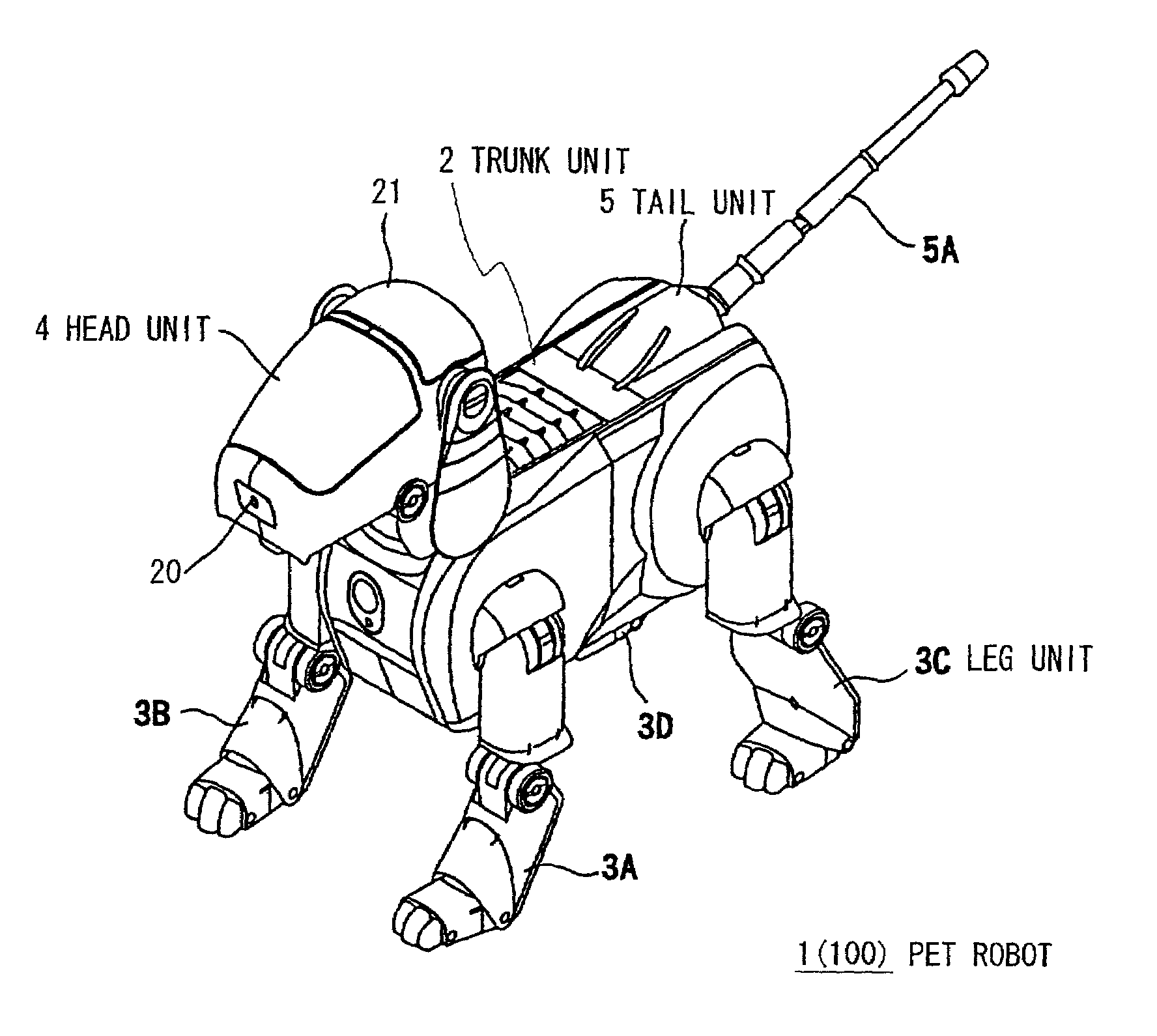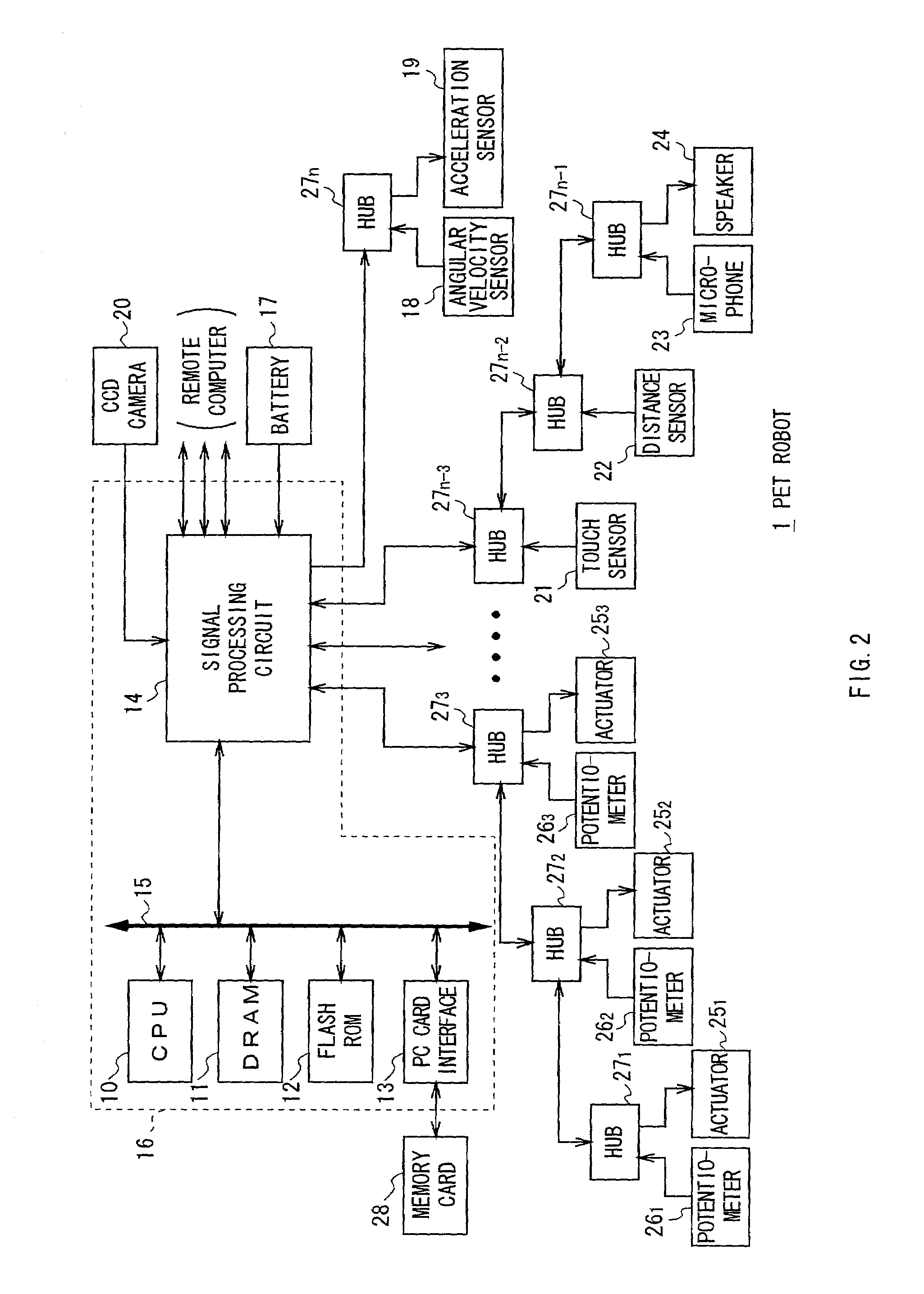Robot apparatus, control method thereof, and method for judging character of robot apparatus
a robot and apparatus technology, applied in the field of robot apparatus, can solve the problems of unnatural feelings, complex operation of generating behavioral models, and the inability to estimate the emotion and instin
- Summary
- Abstract
- Description
- Claims
- Application Information
AI Technical Summary
Benefits of technology
Problems solved by technology
Method used
Image
Examples
first embodiment
(1) First Embodiment
(1-1) Configuration of Pet Robot According to First Embodiment
[0071]In FIG. 1, reference numeral 1 denotes a pet robot according to the first embodiment as a whole, which is configured such that leg units 3A to 3D are coupled to a trunk unit 2 in front and in rear, and on both sides thereof, and a head unit 4 and a tail unit 5 are coupled to the front end and rear end of the trunk unit 2 respectively.
[0072]The trunk unit 2, as shown in FIG. 2, contains a control unit 16 in which a CPU (Central Processing Unit) 10, a DRAM (Dynamic Random Access Memory) 11, a flash ROM (Read Only Memory) 12, a PC (Personal Computer) card interface circuit 13 and a signal processing circuit 14 are connected to each other with an internal bus 15, and a battery 17 as a power source for the pet robot 1. In addition, the trunk unit 2 contains an angular velocity sensor 18, an acceleration sensor 19 or the like for detecting the direction and acceleration of the movement of the pet robot...
second embodiment
(2) Second Embodiment
(2-1) Principle
[0158]When a transition to a series of action patterns PA1 to be newly acquired by the “growth” is made only from a specific state (node NODEA) as shown in FIG. 11, it is possible to control the revelation of the action pattern only by changing the transition probability P1. When, however, this transition occurs from a plurality of states (nodes NODEA1 to NODEA3) as shown in FIG. 13, it is not easy to control all corresponding transition probability P10 to P12.
[0159]In such a case, an imaginary node (hereinafter, referred to as virtual node) NODEK can be provided in the behavioral model as shown in FIG. 14, and transition from each node NODEA1 to NODEA3 to a node NODEB, which serves as a starting point of a series of action patterns PA1, can be replaced with transition to the virtual node NODEK in such a manner that the virtual node NODEK is brought into correspondence with the node NODEB, which is the starting point of the above described series ...
third embodiment
(3) Third Embodiment
(3-1) Configuration of Pet Robot According to Third Embodiment
[0179]In FIG. 18, reference numeral 110 generally denotes a pet robot according to a third embodiment. Leg units 112A to 112D are respectively connected to the front right, front left, rear right, and rear left parts of a body unit 111 and a head unit 113 and a tail unit 114 are respectively connected to the front end part and the rear end part of the body unit 111.
[0180]As shown in FIG. 19, in the body unit 111 a control unit 126, a CPU (Central Processing Unit) 120, a DRAM (Dynamic Random Access Memory) 121, a flash ROM (Read Only Memory) 122, a PC (Personal Computer) card interface circuit 123 and a signal processing circuit 124 are connected to each other with an internal bus 125 and a battery 127 serving as the power source of the pet robot 110 are contained. Further, an angular velocity sensor 128 and an acceleration sensor 129 for detecting the orientation or the acceleration of the movement of ...
PUM
 Login to View More
Login to View More Abstract
Description
Claims
Application Information
 Login to View More
Login to View More - R&D
- Intellectual Property
- Life Sciences
- Materials
- Tech Scout
- Unparalleled Data Quality
- Higher Quality Content
- 60% Fewer Hallucinations
Browse by: Latest US Patents, China's latest patents, Technical Efficacy Thesaurus, Application Domain, Technology Topic, Popular Technical Reports.
© 2025 PatSnap. All rights reserved.Legal|Privacy policy|Modern Slavery Act Transparency Statement|Sitemap|About US| Contact US: help@patsnap.com



